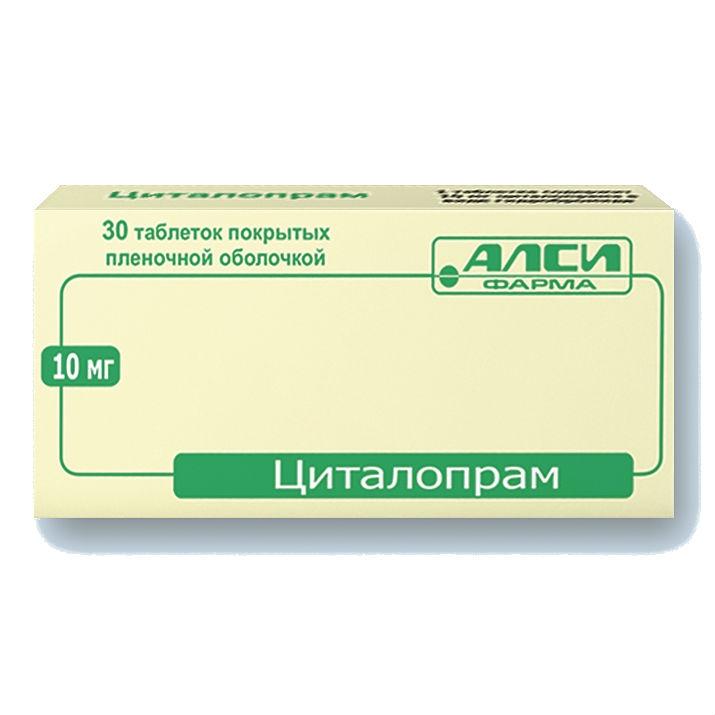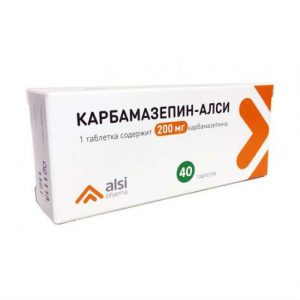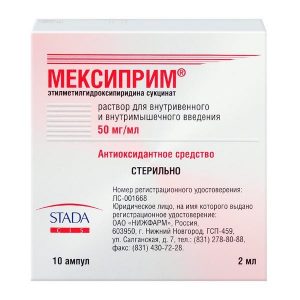Description
Pharmacological action
Pharmacological properties
Combined drug that has antipyretic, anti-inflammatory, decongestant, analgesic and anti-allergic effects, eliminates symptoms.
Pharmacodynamics
Paracetamol. It has analgesic and antipyretic effects similar to salicylates. Paracetamol also exhibits weak anti-inflammatory activity. In equal doses, the degree of analgesic and antipyretic effect is comparable to the action of aspirin.
Paracetamol lowers body temperature in patients with fever but
Packing
30 pcs.
Pharmacological action
Citalopram is an antidepressant that belongs to the group of selective serotonin reuptake inhibitors (SSRIs). It has a pronounced ability to suppress serotonin reuptake, does not have or has a very weak ability to bind to a number of receptors, including gamma-aminobutyric acid (GABA) receptors, H1-histamine, D1- and D2-dopamine 1-, 2-, beta-adrenergic benzodiazepine and m-cholinergic receptors, which leads to the almost complete absence of undesirable effects such as negative chrono-, dromo- and inotropic effects, orthostatic hypotension, sedation and dry mouth. Citalopram only very slightly inhibits the CYP2D6 isoenzyme, and, therefore, practically does not interact with drugs metabolized by this enzyme. Thus, side effects and toxic effects are manifested to a much lesser extent.
The antidepressant effect usually develops after 2-4 weeks of treatment.
Citalopram has no effect on serum levels of prolactin and growth hormone.
Citalopram does not impair cognitive / intellectual functions and psychomotor function and practically does not have a sedative effect.
Citalopram in doses exceeding 40 mg per day can cause abnormal changes in the electrical activity of the heart (prolongation of the QT interval on the ECG).
Indications
– depressive episodes of moderate to severe degree
– panic disorder.
Contraindications
– hypersensitivity to citalopram or to any of the excipients that make up this drug
– citalopram should not be used in combination with monoamine oxidase (MAO) inhibitors, including selegiline, moclobemide, linezolid and antibiotic within 14 days after the termination of their reception. Treatment with MAO inhibitors can be started no earlier than than 7 days after stopping citalopram
– citalopram is contraindicated when used with drugs that extend the QT interval on the ECG (in particular, pimozide), as well as with congenital lengthening of the QT
interval – children under 18 years of age are a contraindication for the use of citalopram, since the effectiveness and safety of its use at this age has not been established.
Use during pregnancy and lactation
Citalopram should not be prescribed to pregnant and breast-feeding women if the potential clinical benefit does not prevail over the theoretical risk, because the safety of the drug during pregnancy and lactation in women is not established.
The use of citalopram in the third trimester of pregnancy can adversely affect the psychophysical development of the newborn. The following disorders are possible in newborns whose mothers took selective serotonin reuptake inhibitors up to childbirth: respiratory failure, cyanosis, shortness of breath, convulsions, temperature instability, feeding difficulties, vomiting, hypoglycemia, muscle hypertension or hypotension, hyperreflexia, tremor, nervousness, irritability, lethargy, constant crying, drowsiness and insomnia.
Epidemiological evidence suggests that the use of SSRIs during pregnancy, especially in late pregnancy, may increase the risk of persistent pulmonary hypertension in newborns. The observed risk was in 5 cases per 1000 pregnancies. In the general population, the risk is from 1 to 2 cases of persistent pulmonary hypertension in newborns per 1000 pregnancies.
Such abnormalities may indicate serotonergic effects or the occurrence of “withdrawal” syndrome. In the case of the use of citalopram during pregnancy, its intake should not be abruptly interrupted.
Special instructions
Children under 18 years of age are a contraindication for the use of citalopram, since the effectiveness and safety of its use at this age have not been established.
Due to the possibility of suicidal attempts, in patients with depression, careful monitoring of patients at the beginning of treatment and the appointment of minimum effective doses to reduce the risk of overdose are necessary. This precaution should be observed in the treatment of other mental disorders because of the possibility of a simultaneous illness with a depressive episode.
Severe depression is characterized by a risk of suicidal actions, which can persist until significant remission is achieved. In this regard, at the beginning of treatment, a combination with drugs from the benzodiazepine group or antipsychotic drugs and constant medical supervision (instructing trusted agents to store and issue drugs) may be indicated. In the treatment of panic disorders with the appointment of antidepressants and / or benzodiazepines, in some patients, in response to the treatment started, anxiety or anxiety is significantly increased. This condition (referred to by specialists as pathological disinhibition or simply paradoxical anxiety, the term itself has not yet been approved) is considered a rare phenomenon, although this pathological reaction has been repeatedly documented in the scientific literature. This paradoxical anxiety usually decreases within the first few weeks after starting treatment. It is recommended that you start with a low dose to reduce the risk of paradoxical anxiety. In this case, drug withdrawal is recommended if such a paradoxical reaction does not disappear for a long time, and if such complications of therapy exceed the benefit of the treatment.
In children, adolescents and young people (under 24 years old) with depression and other mental disorders, antidepressants, compared with placebo, increase the risk of suicidal thoughts and suicidal behavior. Therefore, when prescribing citalopram or any other antidepressants in this category of patients, the risk of suicide and the benefits of their use should be correlated. In short-term studies in people over 24 years of age, the risk of suicide did not increase, while in people over 65 years of age it decreased slightly. During antidepressant treatment, all patients should be monitored for the early detection of suicidal tendencies.
Citalopram should be used with caution in case of renal failure (creatinine clearance below 30 ml / min), hypomania, mania, pharmacologically uncontrolled epilepsy, depression with suicidal attempts, diabetes mellitus, cirrhosis of the liver, bleeding tendency while taking medications, lowering the threshold of convulsive readiness and causing hyponatremia, with ethanol, as well as with drugs metabolized by the CYP2C19 isoenzyme.
Citalopram may cause a dose-dependent prolongation of the QT interval, which can lead to heart rhythm disturbances.
Hyponatremia develops due to impaired secretion of antidiuretic hormone, especially a high level of risk in older women.
Treatment with citalopram may alter glycemic control in patients with diabetes mellitus. The dose of insulin and / or oral hypoglycemic agents should be adjusted.
It is rarely possible to develop akathisia, characterized by a constant or periodically arising feeling of internal motor anxiety and manifested in the inability to sit quietly in one position for a long time or to remain motionless for a long time. Passes during the first weeks of treatment.
Mania may occur in patients with bipolar disorder. Then treatment with citalopram must be discontinued.
It is necessary to use citalopram with caution in the presence of drug dependence (including a history) and a history of epileptic seizures.
Citalopram should not be used in combination with monoamine oxidase inhibitors (MAOs), but caution is required in severe renal impairment. In case of impaired liver function, the drug is limited to the minimum recommended doses. In elderly patients, a dose reduction of citalopram is required.
With the development of a manic state, the drug should be discontinued.
Clinical experience with the simultaneous use of SSRIs and electroconvulsive therapy is insufficient, so caution is required.
Insomnia and anxiety may occur at the beginning of treatment, which can be resolved by adjusting the initial dose.
Abrupt cessation of citalopram therapy can lead to withdrawal syndrome. Undesirable reactions such as dizziness, headaches, and nausea may occur. To avoid the occurrence of the “withdrawal” syndrome, a gradual withdrawal of the drug within a few weeks is necessary.
Influence on the ability to drive vehicles and control mechanisms
Citalopram should be used with caution in individuals whose activities are related to mechanisms or the management of moving vehicles. Citalopram does not reduce the intellectual ability and speed of psychomotor reactions, however, in patients, some decrease in attention and concentration due to the existing disease can be expected, adverse reactions from the treatment or from both of them.
Composition
1 tab. – italopram (in the form of hydrobromide) 10 mg
Excipients: microcrystalline cellulose 46.90 mg, pregelatinized starch 20.20 mg, magnesium stearate 0.40 mg.
Composition of the film coat: Opadry II 3.20 mg, including polyvinyl alcohol 1.28 mg, macrogol 0.65 mg, talc 0.47 mg, titanium dioxide 0.80 mg.
Dosage and administration of
Citalopram is taken orally once a day (without chewing, with a small amount of liquid). The drug can be used at any time of the day, regardless of the meal, it is advisable to take the drug at the same time of day.
Depression
Depression therapy is started with 20 mg of citalopram per day. Depending on the individual reaction of the patient and the severity of depression, the dose can be increased to a maximum of 40 mg per day.
Panic disorder
For panic disorders within 1 week, the recommended dose is 10 mg per day, then the dose rises to 20 mg per day. The daily dose, depending on the individual reaction of the patient, can be further increased to 40 mg per day.
Patients 65 years of age or older
The recommended daily dose for the elderly is 10-20 mg. Depending on the individual reaction and the severity of depression, the dose may be increased to a maximum of 20 mg per day.
Impaired renal function
In chronic renal failure of mild to moderate severity, dosage adjustment is not required. In patients with severe renal failure (creatinine clearance below 30 ml / min), caution in choosing a dose is required.
Impaired liver function
In patients with mild to moderate liver failure, the initial dose is 10 mg per day for the first two weeks. Depending on the reaction, the dose may be increased to 20 mg per day. In patients with severe hepatic insufficiency, extreme caution in choosing a dose is required.
Patients with low CYP2C19 isoenzyme activity
In patients with low CYP2C19 isoenzyme activity, the initial dose is 10 mg per day for two weeks. Depending on the reaction, the dose may be increased to 20 mg per day.
Duration of treatment
The effect manifests itself after 2-4 weeks, the duration of the course of treatment is determined by the condition of the patient, the effectiveness and tolerability of the therapy and is on average 6 months.
Peculiarities of the action of the drug during its withdrawal
Symptoms, which may occur with a sharp abolition of citalopram, are not characteristic. This is most often dizziness, headache, paresthesia, sleep disturbance, asthenia, nervousness, tremor, nausea and / or vomiting.
If treatment is complete, citalopram must be withdrawn gradually over several weeks to avoid withdrawal syndrome. In most cases, approximately 2 weeks is enough for this, but in each individual case, the doctor solves this issue individually: for some patients, a period of 2-3 months or more may be required.
Side effects
As with other SSRIs, the use of citalopram results in undesirable side reactions, but they are transient and mild.
Adverse reactions associated with the use of citalopram are observed during the first one to two weeks of treatment and usually subside significantly as patients improve.
Frequency of adverse reactions: very often -? 10% often -? 1%, but
The following adverse reactions may occur.
Allergic reactions: infrequently – hypersensitivity very rarely – anaphylactic reactions.
From the central nervous system: very often – drowsiness, headache, tremor, dizziness often – migraine, paresthesia, sleep disorder infrequently – extrapyramidal disorders, cramps rarely – serotonin syndrome (a combination of agitation, tremor, myoclonus and hyperthermia) frequency is unknown – psychomotor arousal, akathisia.
From the mental side: very often – agitation, nervousness often – decreased libido, orgasm disorder (in women), anxiety, confusion, drowsiness, impaired attention, strange dreams, amnesia infrequently – aggression, depersonalization, hallucinations, mania, euphoria, increased libido, frequency is unknown – panic attacks, bruxism, suicidal thoughts.
From the digestive system: very often – dry mouth, nausea, constipation often – vomiting, flatulence, diarrhea, abdominal pain, hepatitis, frequency is unknown – gastrointestinal bleeding.
From the cardiovascular system: very often – palpitations often – tachycardia, arterial hypertension, rare orthostatic hypotension – bradycardia, decreased blood pressure, arrhythmia, frequency is unknown – prolongation of the QT interval on the ECG.
From the hemopoietic organs: rarely – hemorrhages (e.g. gynecological bleeding, bleeding of the gastrointestinal tract, ecchymosis and other forms).
On the part of the sensory organs: very often – violation of accommodation often – violation of taste, visual impairment, infrequently – ringing in the ears.
From the respiratory system: often – rhinitis, sinusitis infrequently – cough rarely – dyspnea.
From the reproductive system: often – violation of sexual function, namely violation of ejaculation, decreased libido, impotence, menstrual irregularities rarely – galactorrhea.
From the urinary system: often – painful urination, polyuria.
Metabolic disorders: often – loss of appetite, weight loss, increased appetite rarely – insufficient secretion of antidiuretic hormone (ADH), weight gain, hyponatremia hypokalemia.
From the skin: very often – excessive sweating, often – skin rash, itching infrequently – photosensitivity, urticaria, alopecia, purpura frequency unknown – angioedema, bruising.
From the musculoskeletal system: infrequently – myalgia, arthralgia, increased risk of injuries and fractures.
Laboratory indicators: often – changes in laboratory parameters of liver function infrequently – increased activity of liver enzymes, changes in electrocardiograms (prolongation of the QT interval), hyponatremia.
Other: rarely – hyperthermia, yawning, increase or decrease in body weight.
Drug interaction
Combined use of
is contraindicated with MAO inhibitors
Concomitant treatment with MAO inhibitors is contraindicated (both non-selective and selective) due to the risk of serious side effects, including serotonin syndrome. Citalopram should not be used in combination, incl. with selegiline, moclobemide, linezolid (antibiotic), etc., as well as within 14 days after stopping their use. Treatment with MAO inhibitors can be started no earlier than 7 days after stopping citalopram.
With QT prolonging agents
Do not use with QT prolonging drugs such as antiarrhythmics (procainamide, amiodarone, etc.), antipsychotics / antipsychotics (e.g. phenothiazine derivatives, pimozide, haloperidol), tricyclic antidepressants and SSRIs (fluoxetine), antimicrobials (macrolide antibiotics and their analogs, for example, erythromycin, clarithromycin derivatives of quinolone and fluoroquinolone: sparfloxacin, moxifloxacin gentamisolastin-receptorol-isol-aminol-pentamolines-pentamolines-pentamolines-gentamisol-istolisol-aminopolyisol-aminosolidazole-aminobisol-istamisol-aminopolyisol-aminopolyisol-aminol-receptors-gentamolin azole-type drugs (ketoconazole, fluconazole), domperidone, ondansetron, since citalopram in doses exceeding 40 mg per day can cause abnormal changes in the electrical activity of the heart (lengthening of the QT interval on the ECG) and lead to irregular heartbeat (arrhythmia including development of pirouette type), which can be fatal.
Pimozide
The simultaneous use of pimozide and citalopram is contraindicated, since their combined use prolongs the QT interval. This also applies to such drugs as amitriptyline, maprotiline, venlafaxine, terfenadine, haloperidol, droperidol, chlorpromazine, thioridazine.
Concomitant use of citalopram should be performed with caution:
citalopram may lower the seizure threshold. Caution is required while taking other drugs that lower the threshold of convulsive readiness (tricyclic antidepressants, SSRIs, antipsychotics – derivatives of phenothiazine, thioxanthene and butyrophenone mefloquine and tramadol).
With the simultaneous use of citalopram and tryptophan, cases of increased action of the drug have been reported. It is advisable not to combine serotonergic drugs, such as sumatriptan or other triptans, as well as tramadol with citalopram.
Concomitant use of citalopram and drugs, containing hypericum perforatum (Hypericum perforatum) can lead to an increase in side effects.
With the simultaneous use of cimetidine causes a moderate increase in the equilibrium concentration of citalopram in the blood. Therefore, caution is advised when prescribing maximum doses of citalopram simultaneously with the use of high doses of cimetidine.
With the simultaneous use of citalopram with indirect anticoagulants and other drugs that affect blood coagulation (atypical antipsychotics and phenothiazine derivatives, most tricyclic antidepressants, acetylsalicylic acid and non-steroidal anti-inflammatory drugs, triclopidine, and blood dipyridamines), dipyridamines may occur. In such cases, at the beginning or end of citalopram therapy, regular monitoring of blood coagulation is necessary.
When administered concomitantly with warfarin, prothrombin time increases by 5%.
No interaction of citalopram with alcohol. However, as with other psychotropic drugs, the simultaneous use of citalopram and alcohol is not recommended.
In vitro studies revealed that citalopram is converted into its demethylated derivatives with the participation of the CYP2C19 and CYP3A4 isoenzymes, as well as with a small contribution of the CYP2D6 isoenzyme. It has been proven that inhibition of one of the enzymes can be compensated by other enzymes. The inhibitory effect of citalopram on these and other isoenzymes of cytochrome P450 is weak or negligible, therefore, citalopram has a low ability for clinically significant drug interactions known for this situation. However, caution is needed if citalopram is prescribed in conjunction with drugs that are metabolized mainly by the CYP2D6 isoenzyme and have a low therapeutic index. Although clinical data on multiple dose pharmacokinetic studies are not available, there is in vitro data (model of human liver microsomes) that show a 45-60% and 75-85% slowdown in the formation of demethylated citalopram derivatives compared to the control after the addition of ketoconazole and omeprazole , respectively. This may justify the necessary caution in these cases when prescribing together with citalopram such strong CYP3A4 inhibitors as ketoconazole, itraconazole, fluconazole, or strong CYP2C19 inhibitors such as omeprazole, esomeprazole, fluvoxamine, ticlopidine, lanzoprazole, since their combined administration with citalopram can significantly reduce the clearance of citalopram. Therefore, the maximum recommended dose of citalopram for patients taking together drugs-inhibitors of the CYP2C19 isoenzyme should not exceed 20 mg / day, incl. and because the risk of lengthening the QT interval is increased.
The combined use of citalopram with imipramine or desipramine does not affect the concentration of imipramine and citalopram, but increases the concentration of desipramine. A dose adjustment may be necessary.
Overdose
Overdose symptoms: convulsions, drowsiness, tachycardia, bradycardia, muscular hypotension or hypertension, nausea, vomiting, tremor, serotonin syndrome, agitation, dizziness, dizziness, dizziness, dizziness, dizziness GIS, pulmonary hyperventilation, atrial arrhythmia, ventricular arrhythmia, coma.
Coma and fatal cases of citalopram overdose are extremely rare, most of them include concomitant overdose with other medicines.
Overdose treatment: no specific antidote. In case of overdose, gastric lavage should be carried out as soon as possible. Treatment is symptomatic and supportive. Medical observation is recommended, in case of loss of consciousness and respiratory distress – intubation, as well as careful monitoring of ECG and other vital functions, as there is a high risk of fatal arrhythmias, accompanied by sinus tachycardia, nodal rhythm, QT prolongation, and particularly, development of arrhythmias. arrhythmias.
Storage Conditions
In a dark place at a temperature not exceeding 25 ° C. Keep out of reach of children.
Shelf life
3 years. Do not use after the expiration date indicated on the package.
Active ingredient
Citalopram
Pharmacy terms Pharmacies
prescription
Dosage form
tablets
Possible product names
CITALOPRAM 0, 01 N30 TABLE P / O
Citalopram tab p / p / o 10mg N30
CITALOPRAM TAB. P / O CAPTURE. 10MG No. 30
Citalopram tablets 10 mg, 30 pcs.




